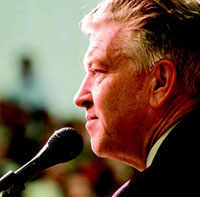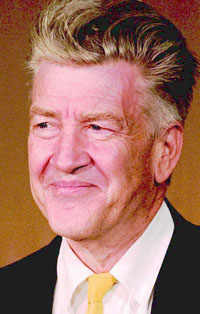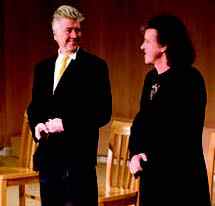MC: You don’t like to speak publicly. You like to stay home and write and cut films. Why are you here?
DL: What brought me here? I think it was last year that it suddenly dawned on me that the David Lynch Weekend was an annual event.
The Third Annual David Lynch Weekend, Exploring the Frontiers of Creativity, Sustainability and Peace, at the Maharishi University of Management (MUM) in April in Fairfield, Iowa was a sold-out event. It was a boon for students, prospective students, parents, community members, filmmakers, novices and long-time Transcendental Meditation (TM) practitioners.
David Lynch’s passion is, of course, cinema. But at one of the weekend sessions when answering a question as to which was more important to him, his art or his meditation, he confessed it would be his meditation. He has practiced TM twice a day, every day, for 34 years. He’s nurturing this love of TM by passing it on to others through the David Lynch Foundation for Consciousness-Based Education and World Peace where he tirelessly promotes TM in educational settings in the U.S. and throughout the world. (See “Adjusting Brain Waves One School at a Time on page 36.)
The weekend event was full of lectures and Q & A sessions featuring Lynch and other articulate spokespeople for TM such as Dr. John Hagelin, world-renowned physicist and leader in propagating Vedic principles to achieve peace and sustainability. They were joined by TM researcher Dr. Fred Travis, who deftly wired his teenage daughter’s head to a brainwave machine for the audience to watch brain wave patterns while she sat silently in a TM state. Pretty heady stuff. By the time evening rolled around, everyone was ready for the entertainment.
At evening concerts in a converted gymnasium, Lynch hosted Moby, Donovan (a Beatles era TMer who Lynch refers to as the “Musical Wing” of the David Lynch Foundation), Crystal Bell (whose music can be heard in Inland Empire) and her band from Austin, Texas, and others on stage. Buses full of folks from surrounding communities rolled in, becoming part of a crowd of around 3,000. Looking like a proud father with a permanent front-row seat, Lynch opened and closed each show. I learned that TM people whoop, holler, stomp, sing along and shake their booties with the best of them, and I didn’t detect an iota of meditation-induced spaciness. Instead TM people talk about things being ‘lively,’ a term they use to indicate that consciousness is bubbling to such a level that the environment becomes enlivened as a result.
Lynch flowed through the sessions and events, available and focused. He moved surrounded by a tight pack of film students and filmmakers who idolize him. Aspiring filmmakers enrolled in MUM’s year-old film department had the chance to have their work critiqued by Lynch. In the middle of all of this, still gracious, smiling and lively, he found time for interviews.
I have to think there’s nary a question he hasn’t heard and already answered. (Question from a student in the audience earlier in the day: Why did you choose to show a bottle of Pabst Blue Ribbon beer in Blue Velvet? David Lynch: Because it’s good beer.) Read his excellent book, Catching the Big Fish, if you want to know more about consciousness, creativity and his commitment to meditation. You’ll also learn a lot about his process.
I think everybody is creative but I think what happens is the weight of the world starts closing in and people stop being kind of childlike and enjoying things. It just sort of squeezes that creative flow shut, negativity does.
JD: You’ve spent your time off-stage this weekend helping film students with their work. Would you express how you feel toward the students at MUM?
DL: I am so impressed with the students at MUM. I have never seen anything like them. They are filled with love, happiness, intelligence, creativity and energy. They really support each other and have such a great time at school. They’re going for their enlightenment and, at the same time, creating peace for our country.
JD: What is an idea?
DL: An idea, I think, is a thought. And thoughts are, you know, bubbling up. And we don’t know them until they enter the conscious mind. Then when they enter the conscious mind we know them. And so thoughts are ideas, ideas are thoughts.
JD: Do you ask an idea what it wants? How do you treat ideas?
DL: I don’t. When I get an idea I see it. Like I say see it, feel it, hear it, I just know it. It comes in…boom! There it is. No question about it, there is an idea. So I write it down. And as I always say, mostly, like if for a feature film, I don’t get the whole feature film at once, I just get a fragment. But that fragment is thrilling. And it holds the promise of something. I write down whatever that fragment is so I won’t forget it. And I write it down in such a way that when I read those words the idea comes back. You know, I see it again. And so then all you have to do is translate the idea. You get a bunch, you know, finally, and no guarantee, but normally you get a bunch and they form a script and then you just translate that to cinema.
JD: Have you ever had a great idea that you’ve later forgotten?
DL: You always think that you won’t forget them. You say ‘this is such an incredible idea, I would never in a million years forget this.’ But I have forgotten in my life at least one thrilling idea that I didn’t write down.
JD: If we stay in the ‘now,’ is that the same as being in meditation?
DL: You can’t stay in the ‘now’ unless you’re in the now. You can’t stay in the now. You can say we’re in the now, but then you know, there is a thing, like Dr. John Hagelin was saying this morning, when you can hold the transcendent in waking, in sleeping, in dreaming, when you are the silent witness. That’s the real thing, no denying it and you’re there. Until then it’s just better to, in my opinion, just go about your business, meditate regularly, unfold the thing. But…this thing of being in the now, it’s more the goal. A lot of people think that they can just say that and they’re there. But it’s a mood making.
JD: Ideas come all of the time, so…
DL: …Ideas come all of the time. Some of them I fall in love with. But like I say, “I’m going to go to the store,” that’s an idea. Everything we do starts with an idea. If you’re going to do anything, there’s some idea that makes you do it. And so, there are different kinds of ideas.
JD: Has it ever happened to you that you think you have an original idea and within days you hear it expressed by someone else?
DL: Yeah. That happens all of the time. Tesla and Marconi, the radio. But Tesla beat him to it, they found out. It’s in the air and many people could catch the same thing. I don’t know quite how it works. It’s just the timing. You know, like, they release a whole bunch of little fish and they kind of disperse. And over here on this bank Sam catches one and over there they can catch the same kind. It’s that kind of thing, I think. But there are times – and it’s not your idea, it’s never your idea, it’s not your fish, it was there to be caught –you catch it and it’s a blessing to catch one.
JD: What does an idea want?
DL: What it wants to do is be translated and be true to. So, a cinema idea comes along and you see it and you get the great joy of translating it to cinema. And you stay true to the idea. I think that’s what it wants. Not change it; be true to that.
JD: When did the light go on for you with Consciousness-Based Education? Can you recall a defining moment? Or did the Maharishi say something or did you simply say, “You know, I think we need to focus on education?”
An idea, I think, is a thought. And thoughts are, you know, bubbling up. And we don’t know them until they enter the conscious mind. Then when they enter the conscious mind we know them. And so thoughts are ideas, ideas are thoughts.
DL: No. I wasn’t a very good student myself. With the David Lynch Foundation for Consciousness-Based Education and World Peace, what I was mostly interested in was the world peace part of it. And when I heard about these peace greeting groups and the fact that people weren’t listening or supporting it, I said ‘well I’d better say something if I get a chance to.’ And then I did hear, like everybody and his little brother, about what was happening in schools.
You know, it’s funny how people get used to things. Now a school shooting isn’t that big a deal. It’s unreal how people adapt to a hell hole. Pharmaceutical drugs, get used to that. Get used to teacher burnout. Get used to people bringing guns to school and stabbings and fights and all this stuff that is never supposed to happen, ever in a million years.
Then you contrast that with Consciousness-Based Education and you could take any kind of troubled school or any good and you could take any kind of troubled school or any good school and still give the students a chance to dive within and unfold their full potential, which is what education is supposed to do. But now, like Bobby [Roth] was saying saying this morning, it’s all just facts and figures. And you cram it into this container.
You know that I picture consciousness as a ball and everybody has consciousness but not the same amount. So everybody’s got a ball of consciousness and you feel bad for somebody with a small ball of consciousness ‘cause they got to put all this stuff in there and there’s not that much room and it’s not that much fun. Consciousness is tied to happiness, creativity, love, all these positive things. Give them a chance to expand that and understanding grows.
The knowledge comes in and they understand it now suddenly. Their IQ truly goes up. They start getting along with their fellow man. They start listening. The teacher looks good to them now. And this stress hitting kids at a younger and younger age, tormented, tormented, not fun going to school, hasn’t been fun for a long time going to school, but it’s even worse now. So Consciousness-Based Education transforms that. It’s proven now. That’s why it’s going to go into more and more schools. The schools that it’s in, people see what it’s done and they start talking. And then this school wants it. And that’s how it’s growing right now. There’s no other thing moving it.
JD: Are you more creative since you started meditating than you were as a child, a teenager or a young adult?

JD: What do you think of the new genre of film called spiritual cinema?
DL: I don’t know anything about it but I like the idea of it.
JD: What was/is your relationship with Maharishi?
DL: I love Maharishi. Maharishi brought a technique for me to unfold my enlightenment and I am so grateful for him.
JD: You have expressed many times why you believe it’s a misconception that an artist must experience suffering in order to create. But then how can you understand and portray darkness, confusion, anger, suffering, tension, etc. through cinema if you haven’t experienced these elements at some point?
DL: The same way you can show a death scene. We just have to understand the highs and lows of the human condition, and understanding grows when we experience the big ocean of pure understanding within.
JD: What makes you sad?
DL: Suffering, ignorance and negativity in the world make me sad, especially when I feel the way they continue even though there is a beautiful, easy way to eliminate it all and enjoy life fully.
See www.davidlynchfoundation.org for information about the David Lynch Foundation for Consciousness-Based Education and World Peace. Also see www.davidlynch.com for the daily weather report, ringtones, store and more information about the David Lynch Foundation. Visit www.moby.com for Moby’s blog about the David Lynch Weekend with photos.
By Julie Deife


